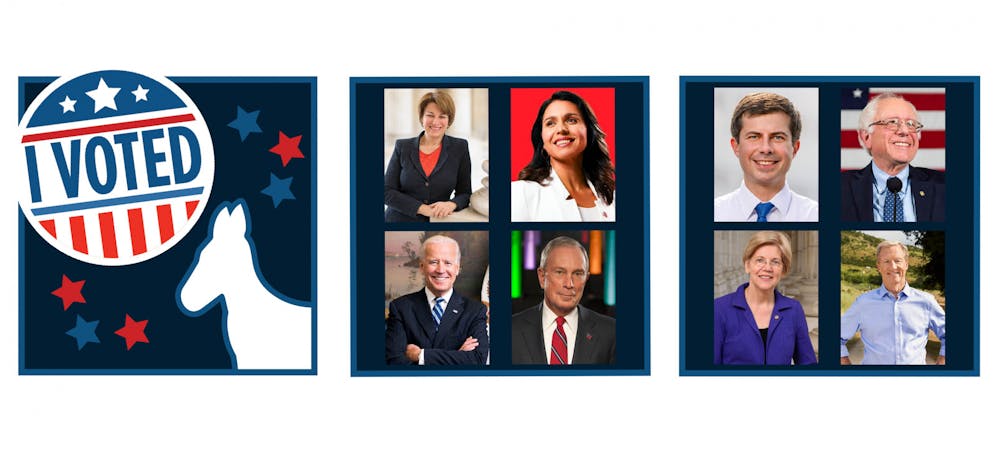Michigan prepares to vote in the 2020 presidential primaries
Young adults in college are among the least likely people to vote in any election, but Michigan's 2020 Presidential Primary is March 10, which is during Central Michigan University’s spring break.
Voting for a candidate in the primary gives them a better chance to be chosen as the party’s candidate. In the Democratic primary, delegates are awarded to candidates based on their proportion of the vote. For the Republican primary, it’s winner-takes-all for each state primary.
However, similar the general election, the popular vote may not be the deciding factor in a primary. Democratic primaries, for example, have superdelegates that can tip the scales more than the average delegate.
Registering to vote
Students can check whether they're registered to vote, and if they are, where they should do so here. To vote, students will have to make sure that either their registered address corresponds to where they are during the break, or they can vote absentee.
If you aren't registered to vote yet, you can register online until Feb. 24 by going to www.michigan.gov/sos and clicking “Register to Vote Online.” You'll need a government-licensed ID number (driver’s license or state ID) or your Social Security number to register.
If you missed that deadline, you can register in-person at a local city or township clerk's office until 8 p.m. March 10. You can either use your current campus address or a previous residence, but you may only register to vote in one place. You can also download the application online and deliver it by hand.
Voting by absentee ballot
As of 2018, Michigan allows voters to request an absentee ballot for any reason. You can vote absentee either by getting a ballot from their local Secretary of State office or filling out a form to receive one by mail, located here.
Requests to obtain a ballot by mail must be received no later than 5 p.m. March 6. Mt. Pleasant City Clerk Jeremy Howard recommends mailing your ballot at least a week in advance of the election. Absentee ballots can also be hand-delivered to a city or township clerk until 8 p.m. March 10.
Emergency absentee voting -- receiving an absentee ballot after the deadline due to an illness or family emergency -- is available for every Michigan citizen until 4 p.m. on March 10.
Voting in person
Students should make sure to bring a picture ID to the polls for verification. They can bring a government-issued ID, like a driver’s license or state ID, or their school ID.
When going to the polls, students must follow a couple of rules: do not vote more than once, and do not bring political memorabilia into the voting place.
Plans for polls
Since the law allowing absentee ballots for any reason in Michigan, secretary of state media representative Jake Rollow says that there has been a higher turnout in the primaries. So far this year, absentee ballot requests increased by 60 percent.
In Mount Pleasant, the city received 572 absentee ballot requests on Feb. 16, 2020, compared to 438 on the same date in 2016, Howard said in an e-mail.
Absentee ballots cannot be counted until 7 a.m. on Election Day. Michigan Secretary of State Jocelyn Benson is advocating for a longer period of time to count absentee ballots. This is due to 63 percent spike in requests, which is greater than the 2016 election cycle.
“We are urging clerks to work diligently and work effectively,” Rollow said.
Michigan will use paper ballots in all precincts to form a “paper trail”, Rollow said, and there will be no new technology introduced.
According to MLive, a little more than 34 percent of registered voters cast a ballot. This broke a record for voter turnout in Michigan, the last highest turnout being in 1972.
History of Michigan's electorate
So what exactly is happening on March 10?
Some states like Maine, Kansas, Nevada, North Dakota, Wyoming, and most notably, Iowa use caucuses, the oldest method for deciding a party nominee. This is when leaders and general members of a political party meet in small groups across the state to coordinate a nomination.
Other states will use open-ballot primaries, in which any voter can participate in each party's ballot, regardless of political affiliation.
Michigan uses a closed-ballot primary. This means voters will state the party primary they wish to participate in before being issued a ballot. The voter does not have to be a registered member of a political party to choose, but they cannot vote on both the Democratic and Republican ballots, according to the Michigan Bureau of Elections.
In March, ballots for Democrat and Republican candidates will be available, but you don't have to declare a party affiliation to vote in either one, Department of Political Science faculty David Rutledge said.
Rutledge served three terms in the Michigan House of Representatives, representing Michigan's 54th district, which includes Ypsilanti and eastern parts of Washtenaw County. He is CMU's sixth Griffin Endowed Chair in American Government, which brings in someone with experience in government to serve as a political science faculty member at CMU for four years.
Since its entry into the union in 1837, Michigan has been inconsistent with its party identification.
"We would call Michigan a blend state. You could look at it as 'purple,'" Rutledge said. "Michigan went red (Republican) for Donald Trump in 2016, which was absolutely unpredictable given how often the state changes allegiance."
In its youth as a state, Michigan consistently voted Republican. From the 1930s through the 1960s, the state alternated between the two parties. Throughout the '70s and '80s, Michigan was Republican red until its transformation into a part of the 'blue wall' that voted Democrat in six-consecutive presidential elections from 1992 through 2012.
Rutledge is ultimately unsure of who will win the Michigan primary, but he says Bernie Sanders' win in the 2016 Michigan primary is a good indicator of what's to come.







